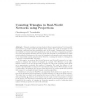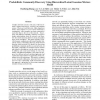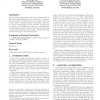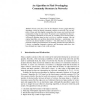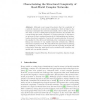128
click to vote
KAIS
2011
14 years 7 months ago
2011
Triangle counting is an important problem in graph mining. Two frequently used metrics in complex network analysis which require the count of triangles are the clustering coefficie...
109
click to vote
GRC
2008
IEEE
15 years 1 months ago
2008
IEEE
Graph-theory-based approaches have been used with great success when analyzing abstract properties of natural and artificial networks. However, these approaches have not factored...
123
click to vote
AAAI
2007
15 years 2 months ago
2007
Complex networks exist in a wide array of diverse domains, ranging from biology, sociology, and computer science. These real-world networks, while disparate in nature, often compr...
ACMSE
2005
ACM
15 years 6 months ago
2005
ACM
Recent research suggests that most of the real-world random networks organize themselves into communities. Communities are formed by subsets of nodes in a graph, which are closely...
122
click to vote
WAW
2007
Springer
15 years 6 months ago
2007
Springer
A random graph model based on Kronecker products of probability matrices has been recently proposed as a generative model for large-scale real-world networks such as the web. This...
115
click to vote
PKDD
2007
Springer
15 years 6 months ago
2007
Springer
Recent years have seen the development of many graph clustering algorithms, which can identify community structure in networks. The vast majority of these only find disjoint commun...
ICPR
2008
IEEE
15 years 6 months ago
2008
IEEE
Scale-free networks are believed to closely model most real-world networks. An interesting property of such networks is the existence of so-called hub and community structures. In...
114
click to vote
COMPLEX
2009
Springer
15 years 7 months ago
2009
Springer
Although recent research has shown that the complexity of a network depends on its structural organization, which is linked to the functional constraints the network must satisfy, ...
